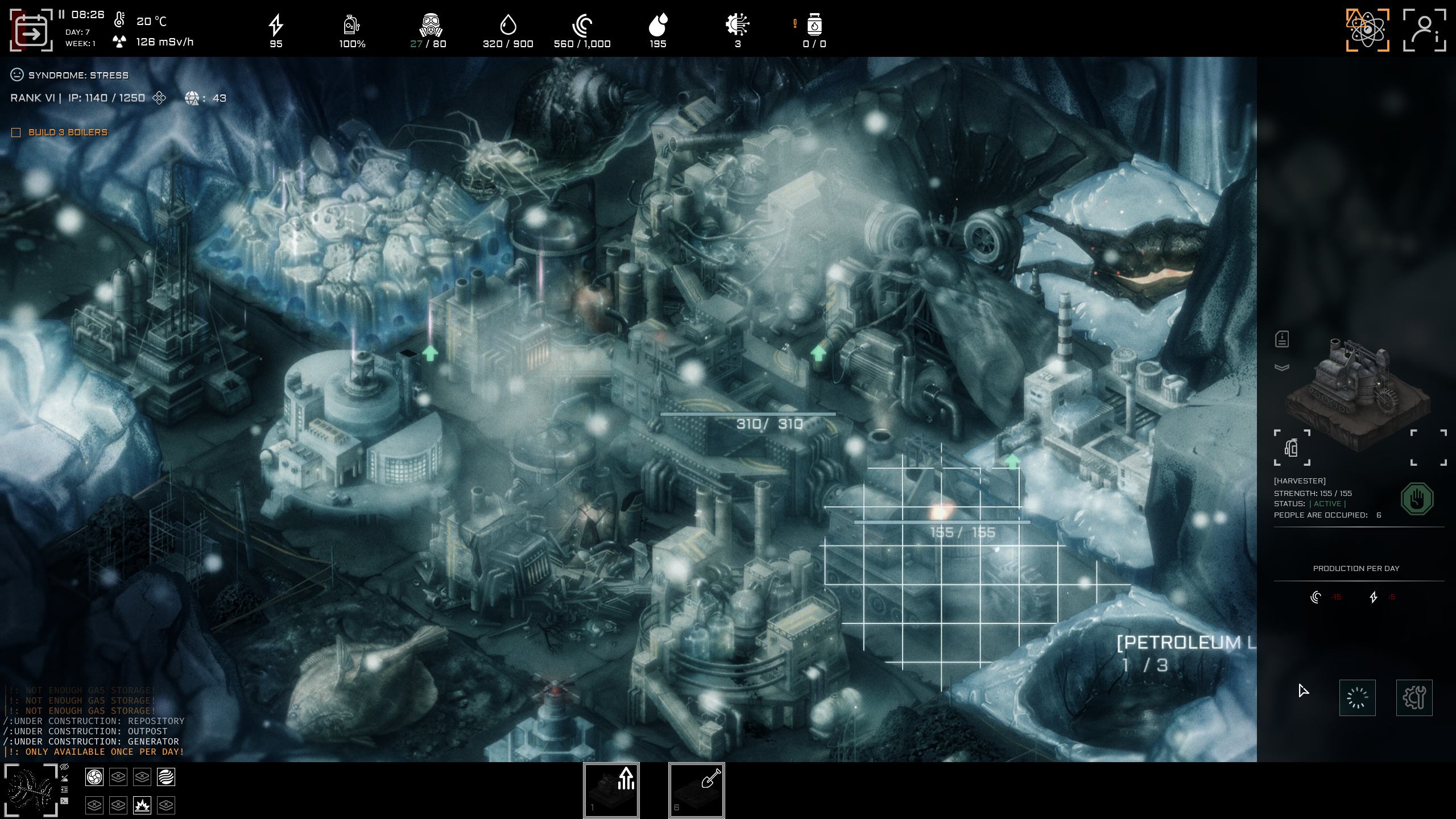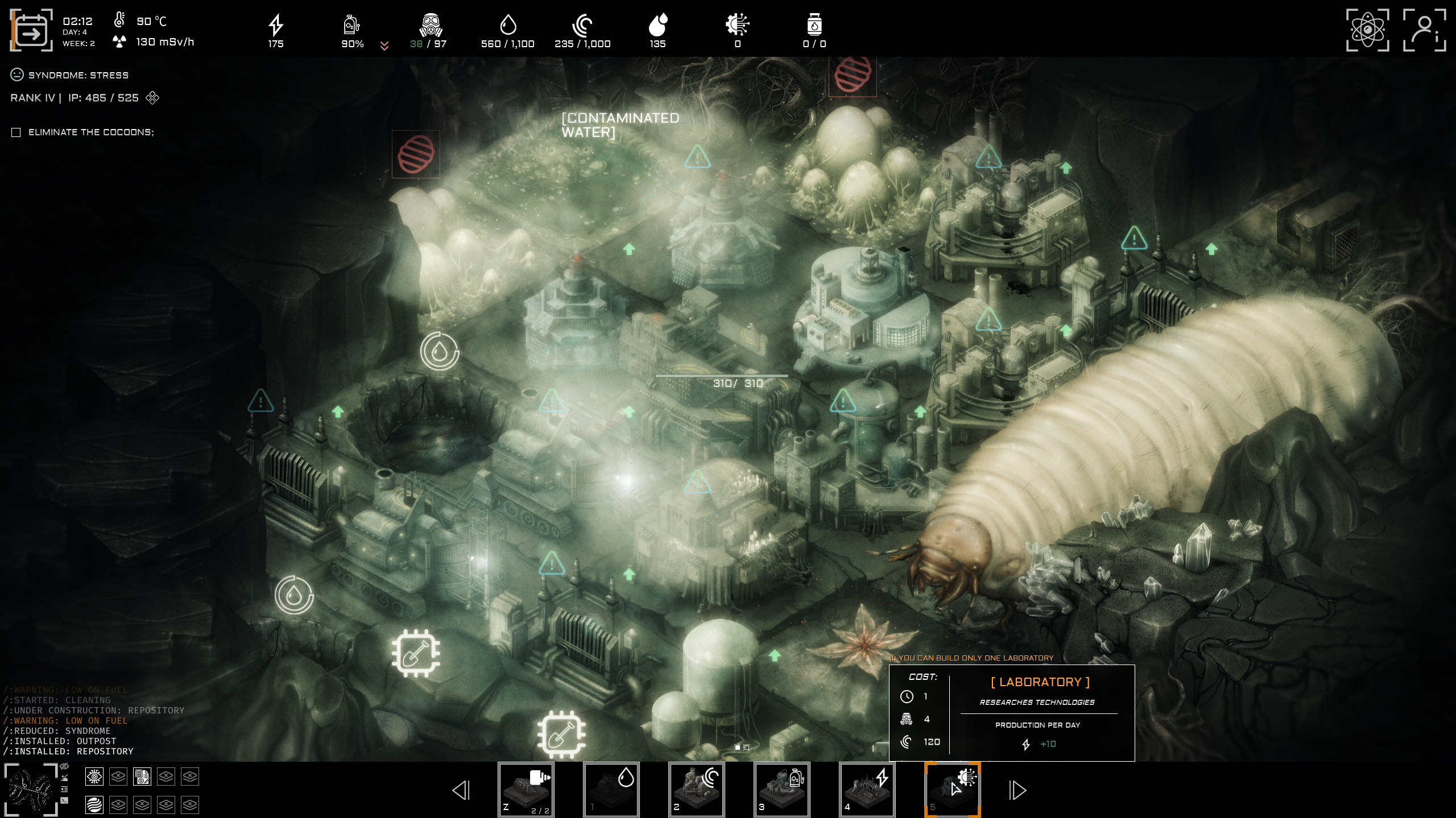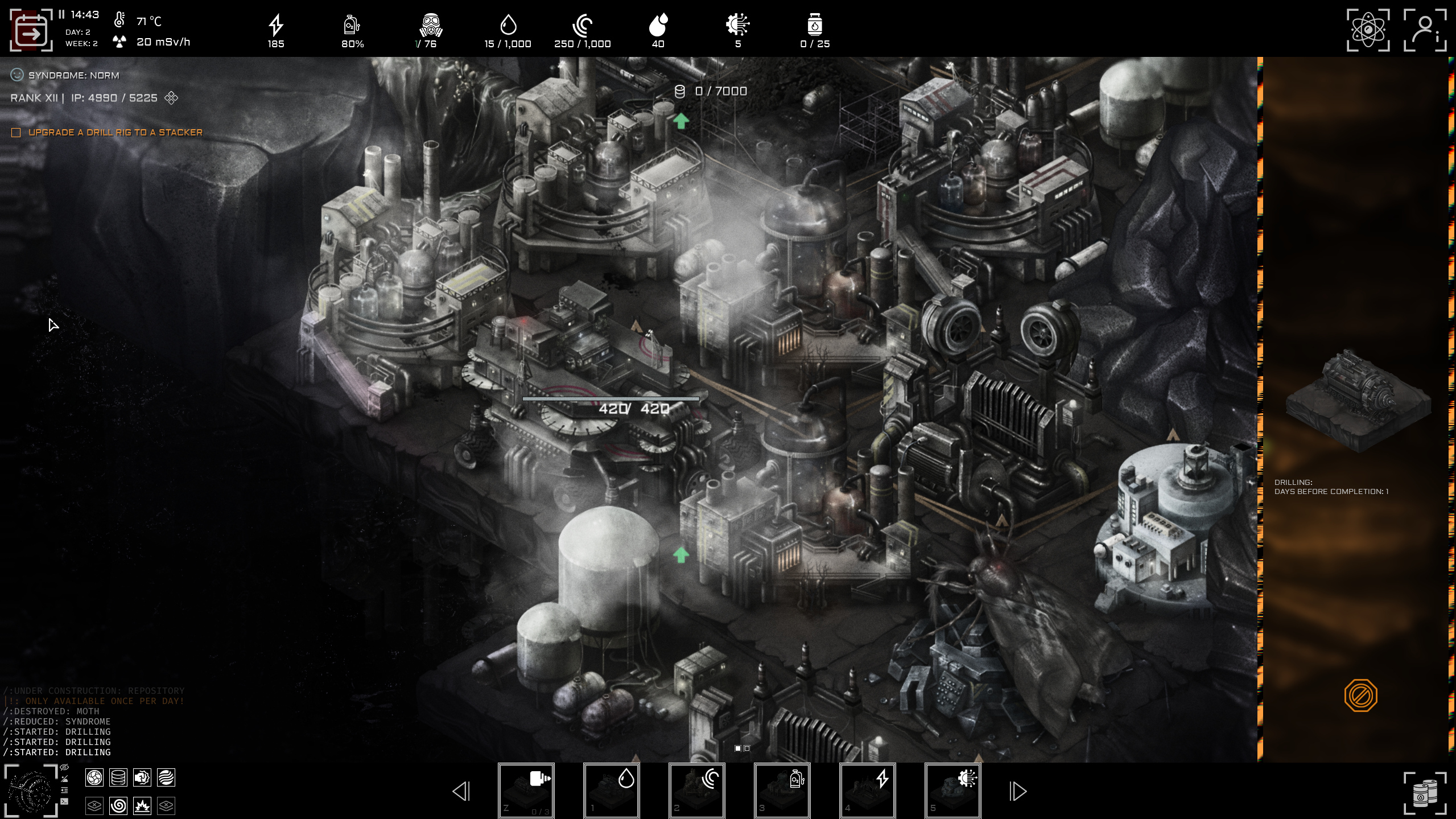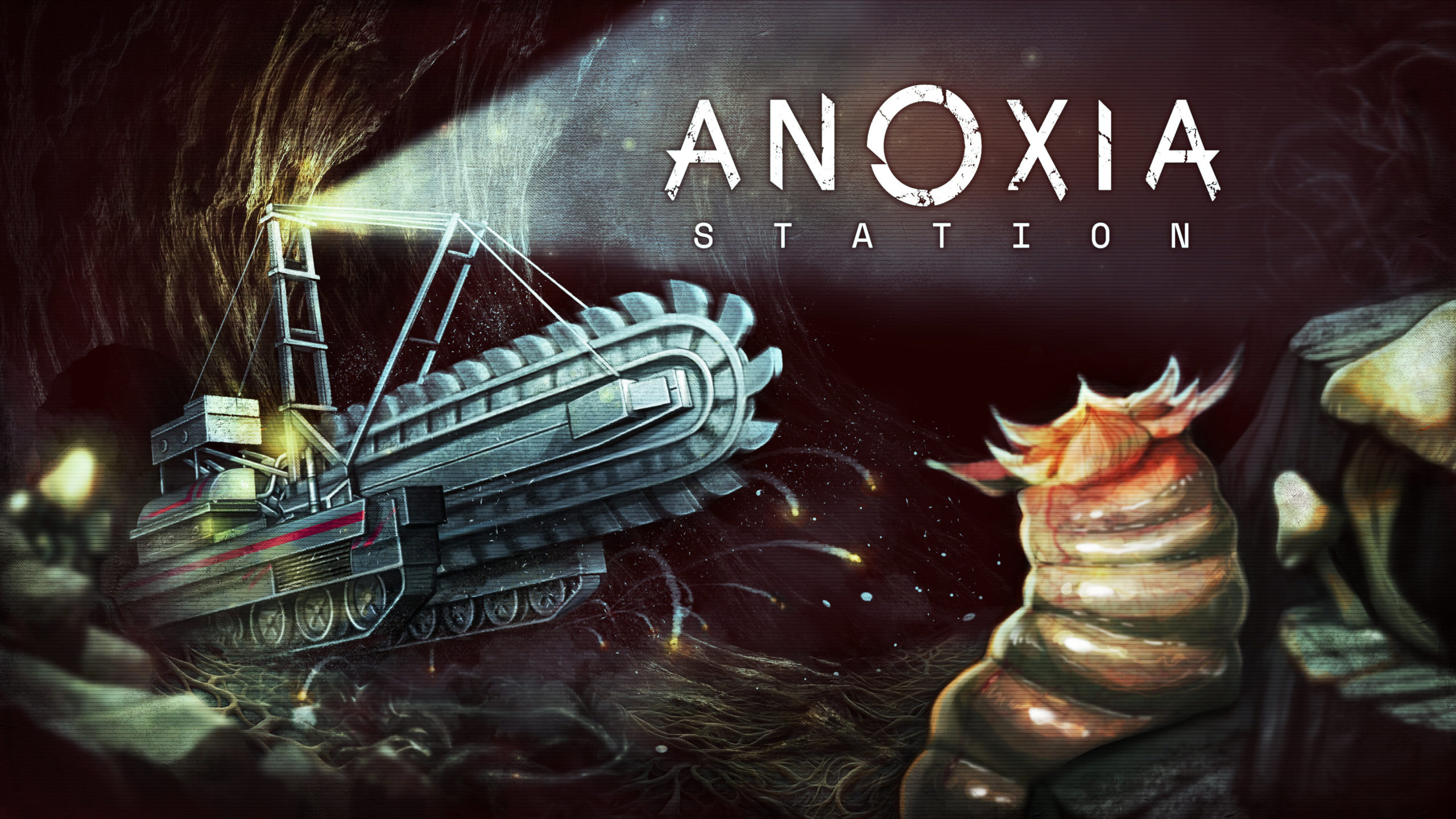As the resident reviewer of the strange yet wonderful quagmire of indie strategy games, Anoxia Station was novel even for me. Obtuse opening, dreamlike visuals, haunting audio and a challenge gradient with the steep incline of a vertical dive. Shiver me timbers, we’ve got ourselves a cosmically terrifying Lovecraftian-inspired survival management sim. Despite the protests of my sanity, I can’t ever pass up the opportunity to delve right into that premise.
Is it worth your time to get down in the dirt with the overly large bugs, spiders and whatever other Eldritch horrors that lurk in the abyss? Suit up your best scientists and miners, it’s going to be a dark descent.
Anxiety Stations
In atypical form, I’m going to start with what I liked most about Anoxia Station, the perturbing visuals and sound. There are six levels or chapters in the game, each containing nightmare-inducing creepy crawlers that can sprawl out of any tile, at any time. Their character models writher, their appearance is accompanied by an other-worldly screech, and their domains are downright unnerving.
While the level design itself isn’t anything major to write home about, the general atmosphere of it is suffocating. Deep, moody colours, dreamlike art style and a mix of active animation coupled with blocky movement where the camera jumps with the hostile biology create a really strong aura. Your station’s structures almost blend into the environment, in a way that makes navigating them cumbersome, but it effectively reflects the weird and unsettling quality of the visuals.
Then there’s the sound. Anoxia Station isn’t marketed as a horror game, but by all the Elder Gods does it sound like one at times. Enemy trigger cues are terrifying, the ambient disquiet when you’re simply running the station is unnerving. If you have the day timer active, you’ll know about it as it screams at you towards the end of another gruelling day surviving this hell pit. I loved all of it. Not only does it nail an obtuse and obscure hostile alien world, but Anoxia Station also does an immaculate job of capturing the fear inherent in the dark depths of a planet’s core.

Drill, Drill and Drill Again
I’m sure Anoxia Station is some kind of perfect allegory for the terror of harvesting our own planet’s resources at the expense of our own madness and survival, but that’s probably too smart for me. The core premise of the game is that you are a mining expedition, sent to extract as much Petroleum as your giant drill can gather. To that end, you must descend through six layers of increasingly brutal areas until you can reach the Holy Grail of fossil fuel extraction.
Along the way, you’ll need to make decisions that affect how many of your crew will survive. You’ll manage resources that maintain the operation of the expedition, fight off a variety of increasingly devastating nasties, and probably die in the attempt. Anoxia Station is a building or base management chassis with a flavourful colouring of a rogue-like sprayed onto the exterior. You can chapter select, but you’ll start with a completely fresh base, whereas continuing on a save maintains upgrades acquired and the crew number you made it to that point with.
Aside from a couple of lovely madness-inducing cutscenes and text exposition, most of the story is interpretive and left to your imagination. The handful of characters are reduced to glorified gameplay abilities with barely any interaction or dialogue. While it’s barebones, that’s kind of the point, so while I do lament that it didn’t have more flesh on its horrifically deformed skeleton, I appreciate the less-is-more approach Anoxia Station takes with setup and narrative.

To Arms, Station!
Of the six chapters you must progress through in the campaign, each has its own objectives and obstacles. One may require you to eliminate harmful fauna littered across the map, another demands you restart a long-abandoned research centre by… finding generators littered across the map. As you progress, more varieties of obstacles and enemies will block your path. Interestingly, though, the game is hardest at the start, rather than towards the end.
There seems to be a bit of a problem with Anoxia Station’s balancing of difficulty, owing to the fact that once you get to grips with the mechanics and you’ve levelled up your main base, you get access to ludicrous build and ability options which trivialise the experience. Abilities are tied to structures, so having offensive options or the means to generate power, oxygen or fuel is determined by the level of your buildings. You can assign characters for day-long buffs, but the effects are negligible.
Instead, the hardest task I found with the game was balancing exploration to break the fog of war in time, while maintaining enough resources to not die, all before the in-game timer ran out. After a set number of days, an earthquake will shatter your base. You need to have ticked off your objectives, while still having enough turns to move your base to an escape point. While it’s incredibly stress-inducing, this constant alarm keeps the tension high when the rest of the mechanics don’t always manage to succeed in such.

Anauseas Station
In a couple of chapters, you’ll likely find yourself in a bit of a loop of firing off offensive abilities, waiting for drilling or resources, then just rinse-repeating that until you stumble on the right object or have enough of X to finally move on. Thankfully, the campaign has enough to sustain itself for its 4-hour runtime (for me, anyway). I largely enjoyed my time with it, but it’s a shame that the initial pressure and intensity of the first two chapters gave way to it being too easy beyond that.
There were some other issues that cropped up for me, too. The manual save system in the menu simply doesn’t work, so I’d advise ignoring it and only trusting the autosave system instead. In one of the game’s more climactic fights, the colour scheme shifted to all black-and-white, with a huge figure covering the mass of the level. Great for spectacle, bad for actually seeing where the target was I needed to destroy. Spent ten minutes clearing the entire map only to realise it was just covered by its body.
Anoxia Station is one of those earthly finds where the gem is valuable, but has a few rough edges, to say the least. The mix of building types is great, the upgrade tree meaningfully expands your abilities (though it maxes out far too quickly) and the need to balance speed to gather resources against overstretching and getting swarmed by enemies is tense and satisfying. I think it just needs a bit more fine-tuning and adjusting of its systems to make it more satisfying throughout the campaign, rather than just at the start.

Come For The Petrol, Stay For The Madness
When all was said and done though, it wasn’t really the gameplay that made Anoxia Station memorable or an indie gem for me. No, it was the commitment to the unnerving and unsettling visuals. The audio cue scream that shook me in my seat or the appearance of some terrifyingly malformed abnormality screeching doom to my station. In one chapter, I escaped with two turns remaining and a sliver of fuel, exhaling a huge sigh of relief as I did so. That’s the sauce that makes Anoxia Station’s petrol so intoxicating.
It has some issues, to be sure, but with a project developed on the minuscule scale with which this has been crafted, that’s to be expected. I’m genuinely interested and curious to see what the developers can cook up next. My planetary excursion into this hostile and alien tunnel system was nothing if not compelling, after all. Maybe I’ll just see what that brain on legs has to offer me and my expeditionary crew, what could go wrong?
Anoxia Station is available May 9th on PC via Steam (review platform).
Developer: Yakov Butuzoff
Publisher: Abylight Studios
Disclaimer: In order to complete this review, we were provided with a promotional copy of the game. For our full review policy, please go here.
If you enjoyed this article or any more of our content, please consider our Patreon.
Make sure to follow Finger Guns on our social channels –Twitter, Facebook, Twitch, Spotify or Apple Podcasts – to keep up to date on our news, reviews and features.
